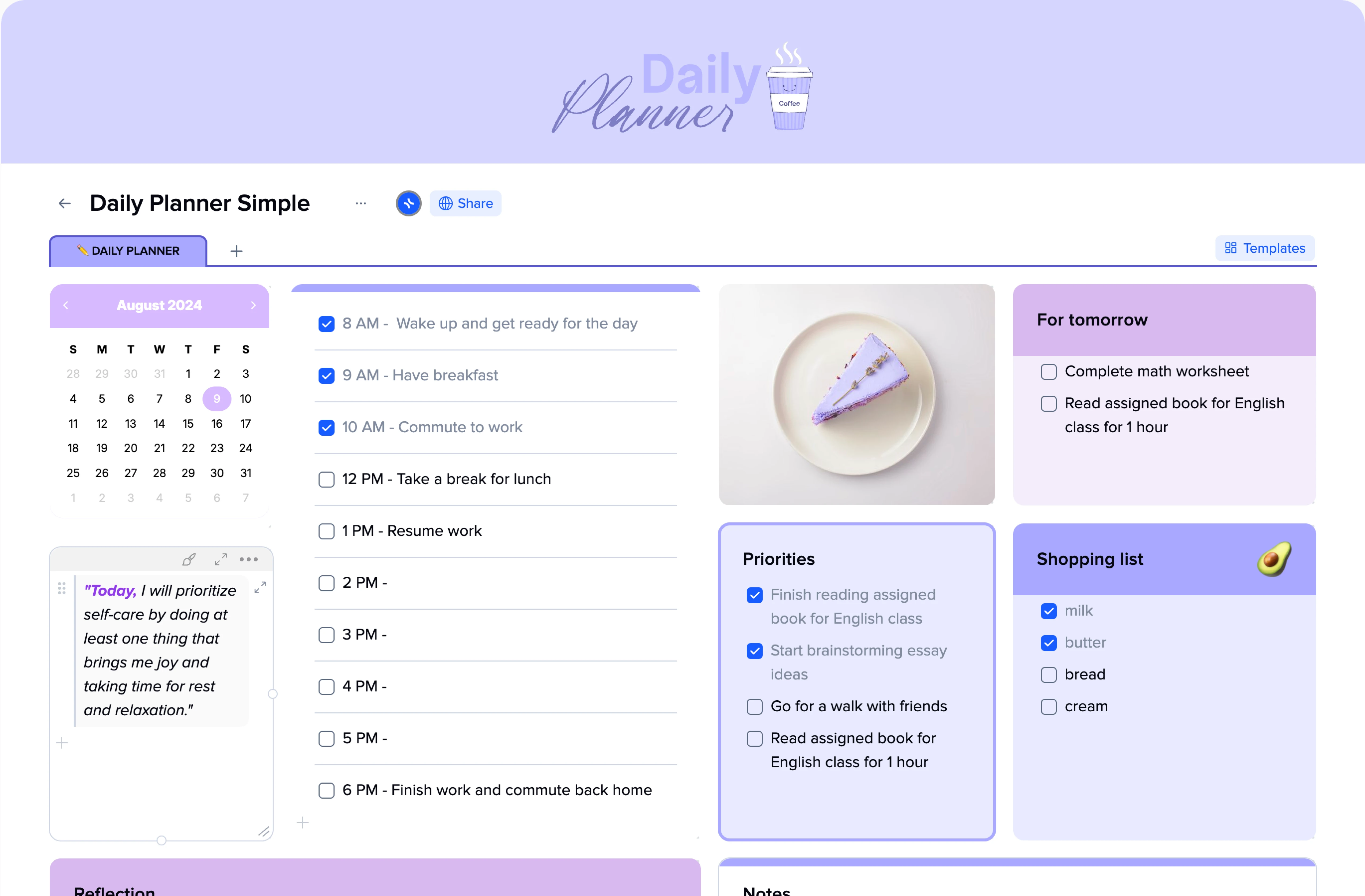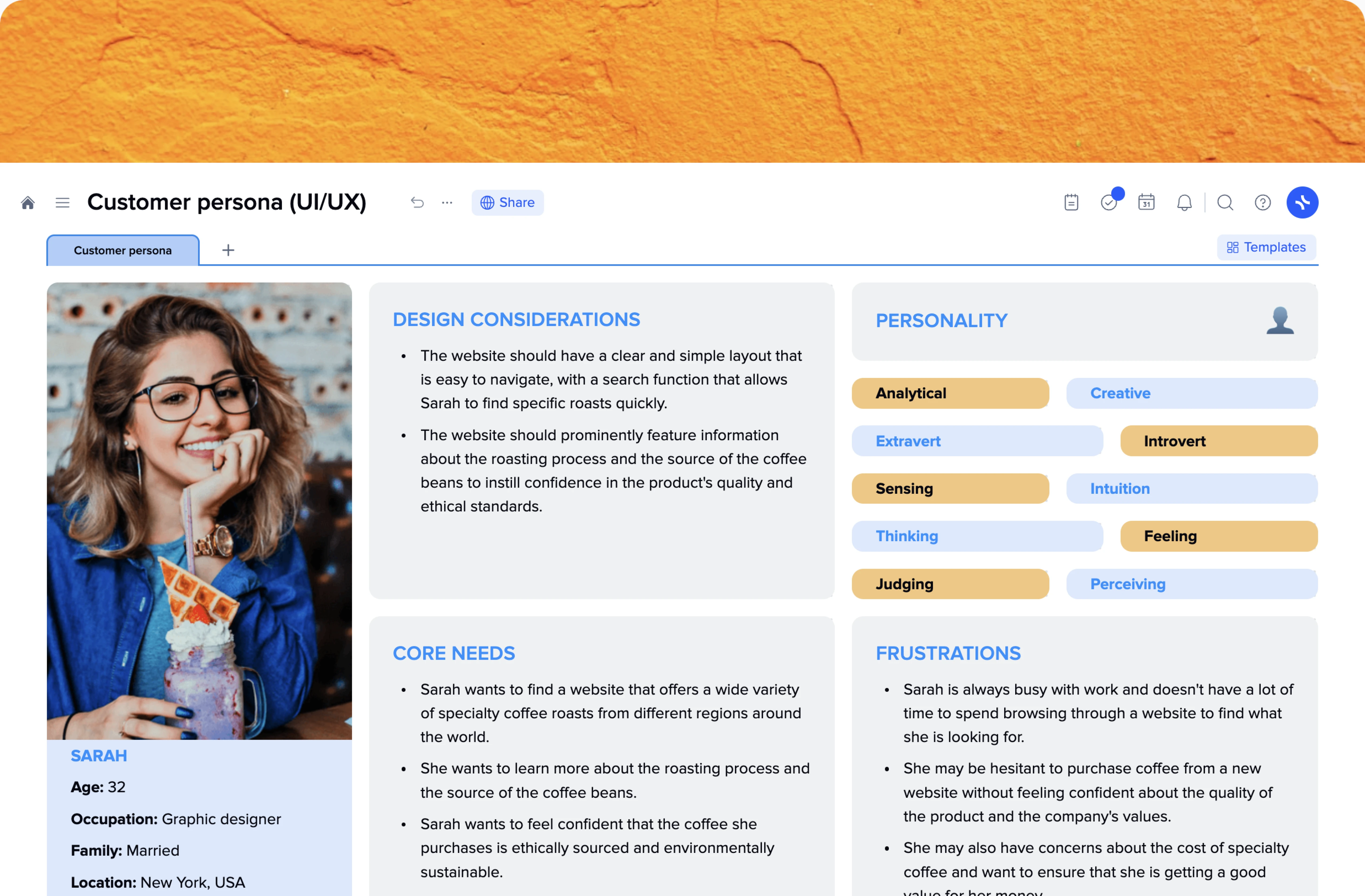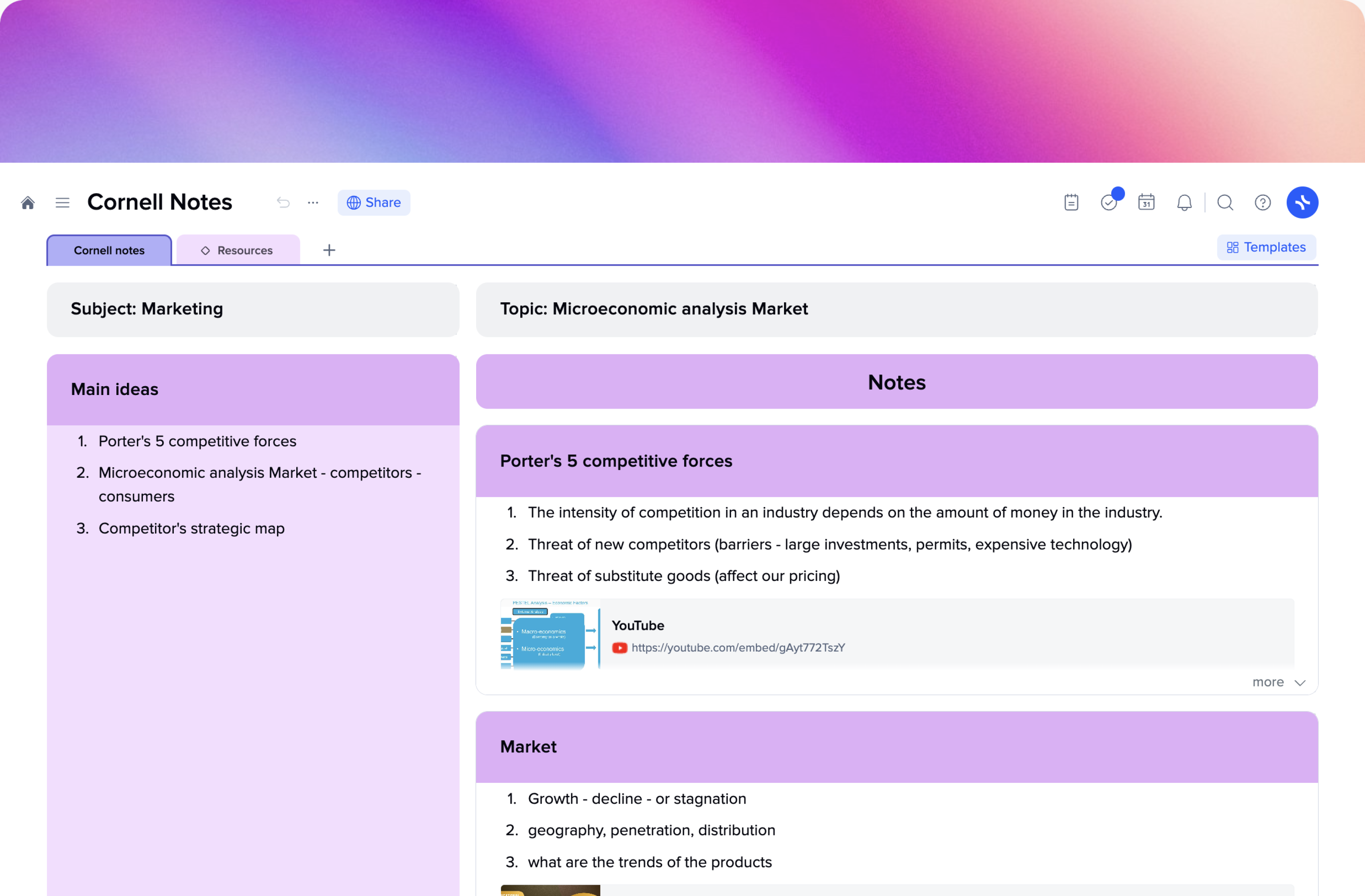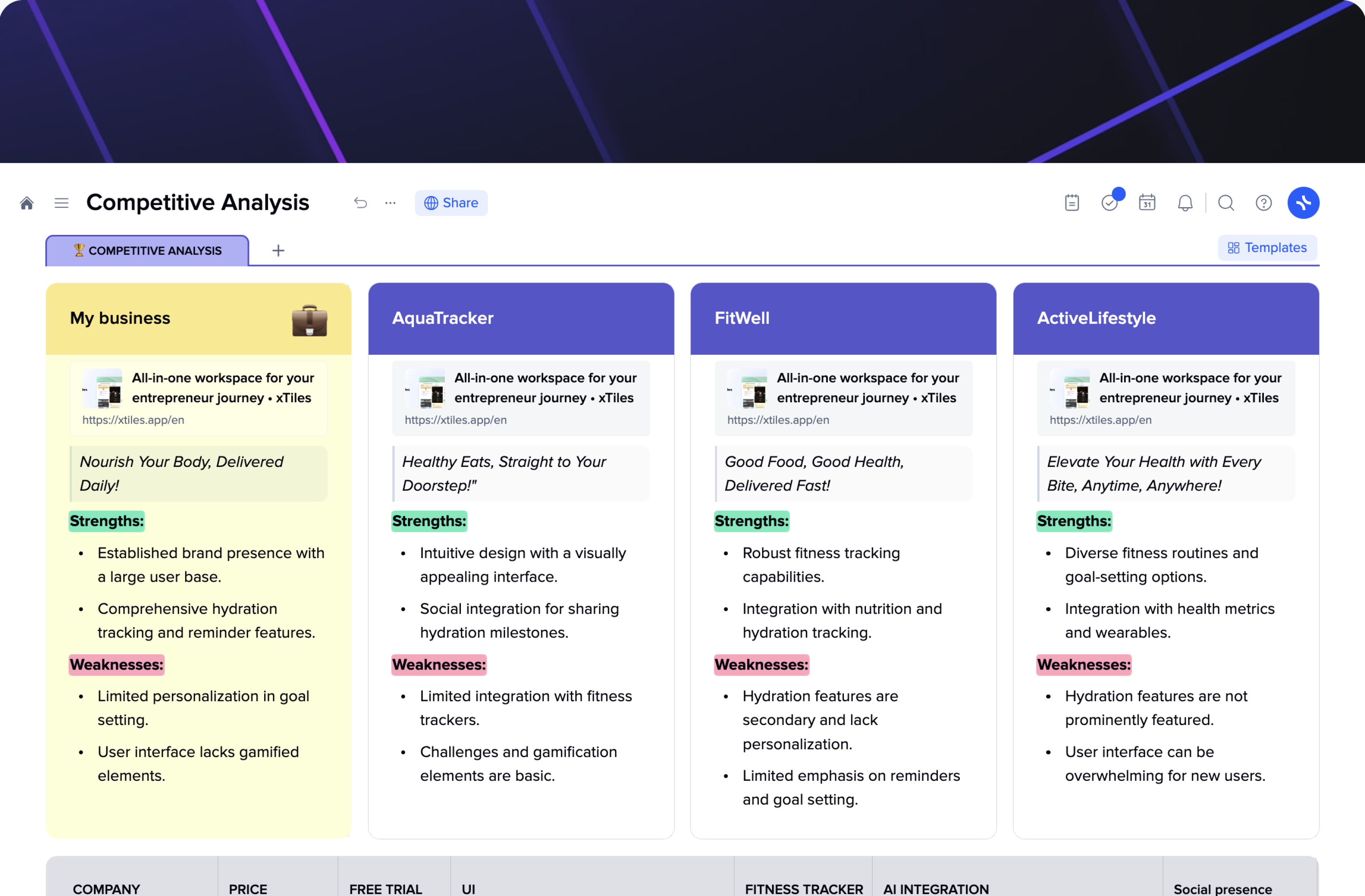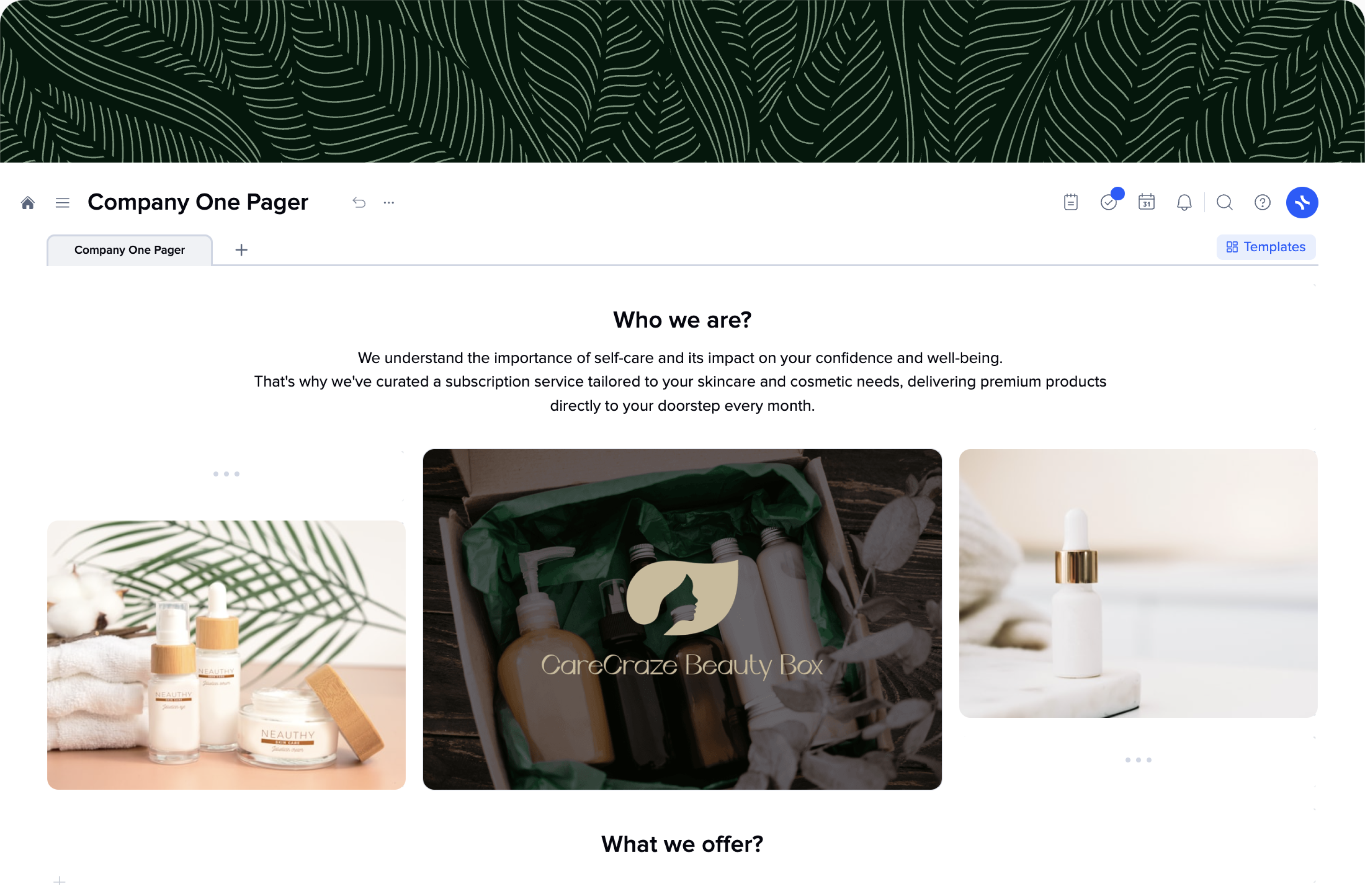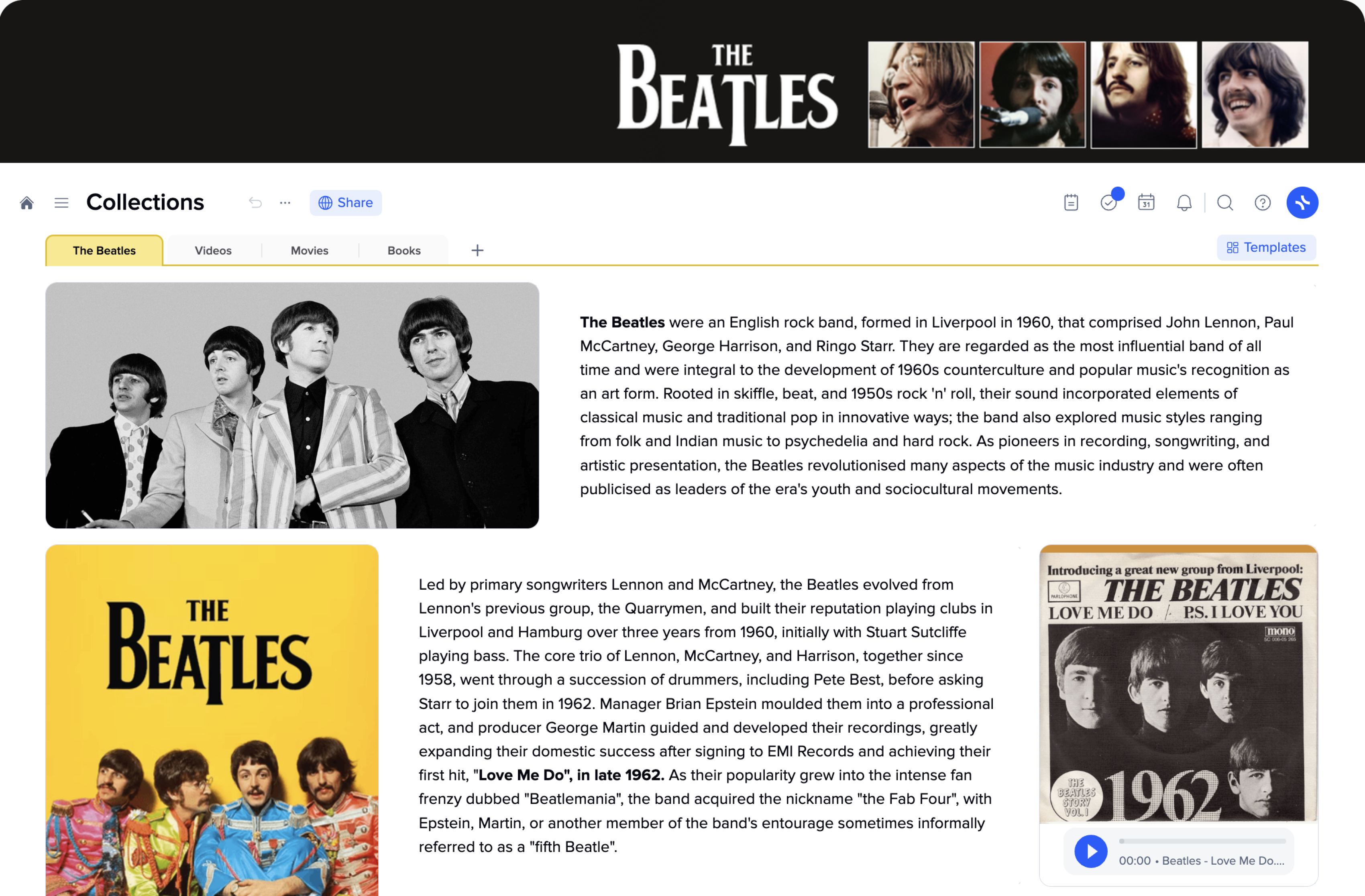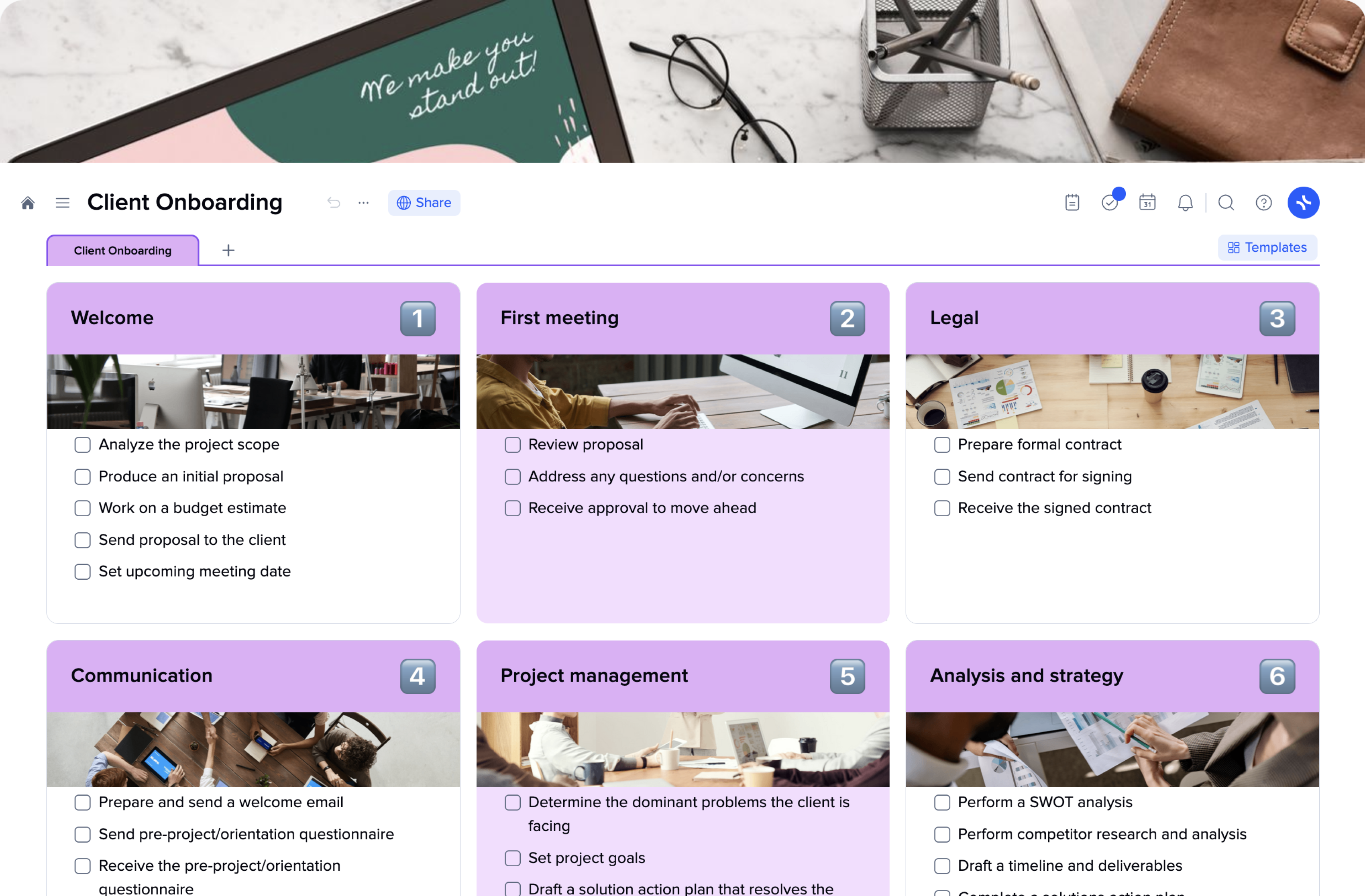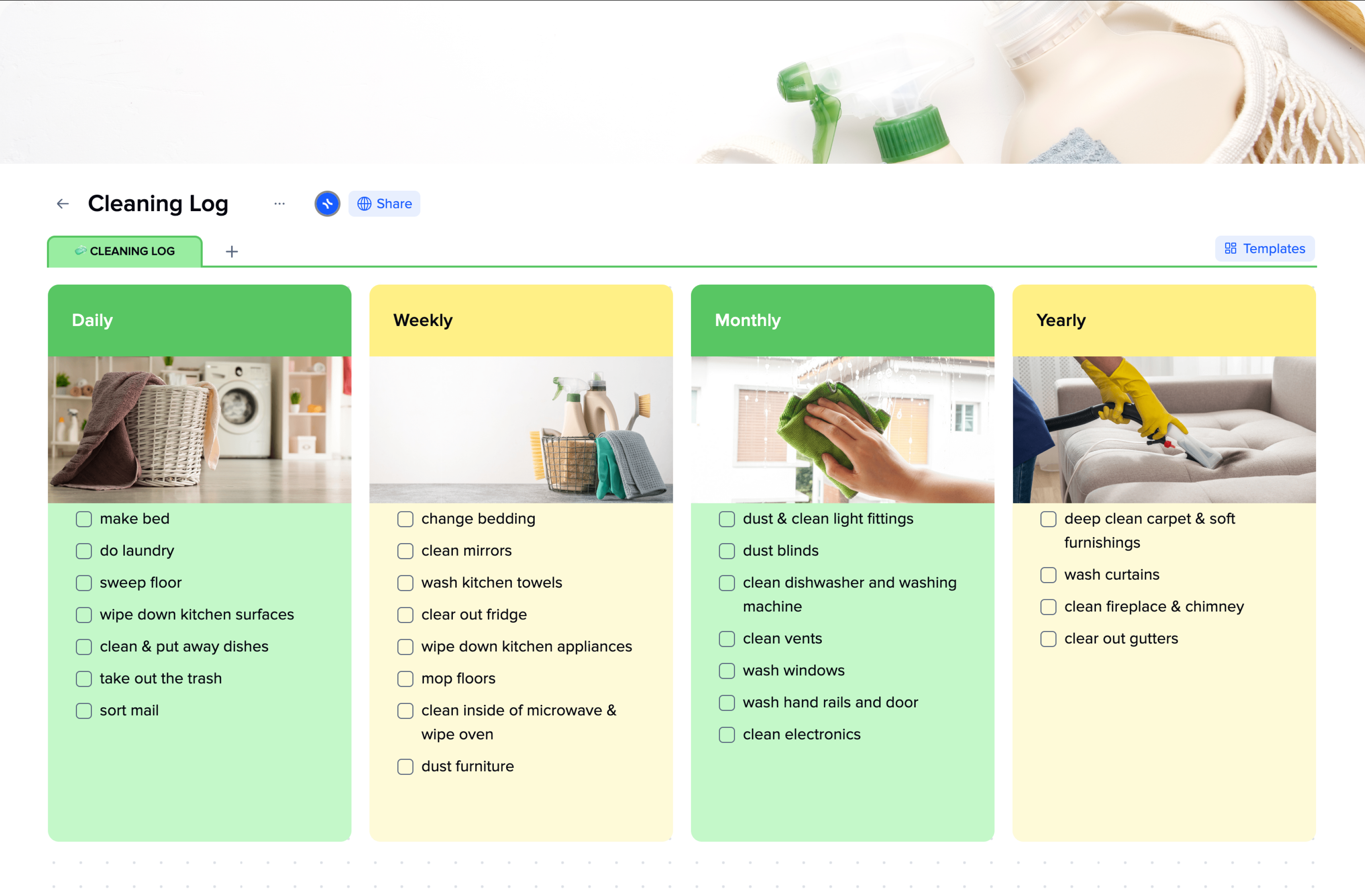Daily Planner Templates – interactive free template for day planning
Whether your day will be productive and great depends on many factors, not all of which depend on you. However, there are many ways to ensure you will fully use these 24 hours to your advantage.
A daily planner is a tool to organize and plan out tasks, appointments, and activities for a given day. It helps ensure that you remember important tasks or appointments. It can also help you prioritize your activities and make sure that you’re spending your time on the most important things.
Daily task planners can be of two types – physical or digital. The first one slowly but steadily gives up on digital planners due to a lack of customization and editing futures.
A daily planner template is the next step of planner evolution. It provides users with pre-designed calendars that often include sections for different categories, such as work tasks, personal errands, exercise, and meals. Some daily planners also have space for notes, goals, and priorities, which can help you stay focused and productive throughout the day.
The xTiles Daily Planner is the perfect tool for arranging your day easily. However, to make your plan feasible, we also offer a guide on how to make your daily planner and an example of a daily planner.
Let’s create your best daily planner!
Which daily planner is the best: digital or printed?
The choice between daily planner printables and digital planners ultimately comes down to personal preference and the time and patience they have to write down every daily goal and task.
Digital daily planners benefits
-
They are easily accessed and synced across multiple devices (even if you use both iOS and Windows, or iOs and Android), making it easy to keep schedules and tasks up-to-date.
-
They often have built-in features such as reminders, alerts, and the ability to set recurring tasks.
-
They offer supportive tools like a habit tracker, all kinds of to-do lists, bills tracker, etc.
-
Digital planners are often more environmentally friendly than printed planners and notebooks since they don’t require paper.
-
The layout can be easily edited and customized without harming the overall appeal if plans change.
-
Daily planner apps help people stay connected with their tasks while on the run and excel in getting things done quickly. It might be quite uncomfortable to carry a notebook or a shit of paper everywhere you go, especially if your job requires a lot of movement.
Printable daily planners benefits
A daily task planner may be printable, which has some benefits too. For example, daily planners in pdf are quite popular for their designs. Writing things down by hand has been shown to improve memory and cognitive function. Some people claim that printed planners also offer a greater sense of satisfaction and accomplishment when they physically cross off completed tasks.
A digital daily planner may be a more beneficial option for people who value accessibility, convenience, efficiency, and customization options over the special vibe a notebook planner may bring. However, it ultimately comes down to personal preference, and some individuals may still prefer a printed planner for their planning needs.
When can a person benefit from using a daily planner template?
A person can benefit from using a daily planner template in many situations. Overall, everyone will find something useful in regular planning. The more tasks a person needs to manage during a day, the more they need a planner to keep everything in their mind. The more tasks a person needs to manage during a day, the more they need a planner to distribute their tasks evenly.
For those relying on memory and improvisation
It may be especially helpful for those who rely on their memory and improvisation and those looking to improve their time management skills, increase productivity, and reduce stress.
For those with busy schedules
One of the main benefits of using a daily planner template is that it helps people manage their time more effectively with less effort. By allowing one to schedule a day and prioritize tasks, an online daily task planner ensures that the time is used in the most efficient way possible. Those with busy schedules or many responsibilities to manage during the day may find it helpful.
For increasing productivity and avoiding burnout
A daily planner template also helps people to increase productivity while protecting them from burnout. One can accomplish more in less time if staying focused and organized and not wasting time finding out what to do next.
For those with important projects
People who have a lot of tasks to complete, or especially those who are working on important projects that require a high level of concentration, may find a planner to be a huge support.
For tracking progress and long-term goals
A daily planner template can be an effective tool for people who prefer to set their tasks and goals in one place and track them easily.
Many people believe that daily planners are worth nothing in the long run. However, making and using them can be particularly helpful for those working towards long-term goals, such as starting a business, learning a new skill, or completing a degree program. They become very detailed documentation of progress and help analyze actions for further planning.
A planner allows breaking down big goals into smaller, actionable steps so that you can stay motivated and on track during the day.
For reducing stress and anxiety
Using a daily planner template can also help reduce stress and anxiety people may experience without a strict plan or when they don’t know how to plan effectively.
If a person knows exactly what they need to do and when they are more likely to avoid the stress of forgetting important appointments or deadlines. That can be especially beneficial for those who struggle with anxiety or have many responsibilities to manage.
For delegation and team management
Finally, daily planner templates are useful for managers or those in leadership roles in their ever-lasting struggle to delegate tasks and ensure everyone is on the same page.
In conclusion, a daily planner template may come in handy to anyone who wants to improve their time management skills, increase productivity, and reduce the stress they usually face because of a lack of planning or a lack of knowledge on how to plan effectively. Whether you’re a student, a professional, or simply looking to stay organized, a daily planner template can help you achieve your goals and stay on track.
Additionally, it’s important to know that people don’t have to be a CEO of a huge corporation to consider themselves a busy person who needs a planner. Starting from school students and finishing with a part-time job of any kind, a daily planner is a tool to help you manage your tasks and appointments, whether there are only three or fifteen of them, more efficiently.
What may I include in my daily planner?
A daily planner helps keep track of schedules, tasks, meetings, appointments, deadlines, goals, etc. Since daily planners are hugely personal, there’s no one-fits-all list that everyone can put into their planner.
What a person includes in their daily planner will depend on their personal needs and preferences, but some common items can be useful to include.
First and foremost, you may create a to-do list. That should include all the tasks you need to complete that day, prioritized based on their importance or urgency. That may help you stay focused and ensure you use your time efficiently.
Next, you may note any appointments or meetings scheduled for the day. It may be helpful to include the time and location to arrive on time and prepare.
If you have any important reminders or deadlines that you need to remember, write them down as well.
You may also want to set specific goals for the day. That could be a particular task that you want to complete or a goal related to your personal or professional development. Writing down your goals can help you stay motivated and focused throughout the day.
If you plan to prepare meals or snacks for the day, you may write down what you plan to eat and when. That section may become essential for people who must follow some dietary restrictions or try to stay on track with their nutrition and avoid last-minute decisions that may not be the healthiest.
You may also add your planned exercise or physical activity. That may help you prioritize your health and well-being and ensure you’re making time for movement.
Finally, include space for notes or ideas that come up throughout the day. They may be ideas for the next day’s planning and be a helpful way to jot down important information or inspiration that you may want to revisit later.
Remember, your daily planner should be a tool to help you and only you stay organized and on track. No one will see it unless you decide to share it. So, let peer pressure not define what you put in your daily planner. Do you want to schedule your leisure time? You’re welcome!
Additionally, your daily planner must not become a source of stress. If you feel overwhelmed from checking it, then you need to review your approach to planning.
Keep your planner manageable and realistic, and adjust it as needed throughout the day.
How to create an effective daily planner using the xTiles Daily Planner Template?
Creating an effective daily planner involves several steps. However, your planner will depend on what sections you want to include. The xTiles Daily Planner Template can be customized according to your planning needs.
Also, not all the days are the same. If yesterday you were exceptionally busy and productive, today you may feel less energetic. A planner will help to organize your day depending on your current potential.
There are two main approaches to creating a plan for the day. Some people prefer to end their days by planning the next ones. Some people start their days by planning what they want to manage today.
If you have never used planners, you may try both of these approaches to find which one suits you best.
Start with defining your goals. That will help you to focus on the most important tasks and avoid wasting time on less critical activities.
You may prioritize a task or two and put them into the “Don’t forget” section. It’s important to remember that not all of your tasks or goals deserve to end in that section. Some of them are meant for the “Daily tasks” part.
When scheduling your tasks and routine, you may divide your day into AM and PM to better understand what you need to accomplish. Daily hourly planners help people keep their focus throughout the day.
If you have a large project or task to complete, break it down into smaller, more manageable tasks. That may turn an overwhelming task into an easier-to-accomplish one.
It’s essential to take breaks throughout the day to rest and recharge. Otherwise, you may not finish everything you planned simply because you lack energy. Schedule breaks into your planner, and take them when needed during the day.
Add details regarding your tasks into the “Notes” section of your planner. That may be something you need to take to your meeting, something you want to ask someone or check later. Write down all of your ideas to have them handy.
Another important part of a planner is daily affirmation. It may sound like something unnecessary for successfully accomplishing your daily tasks, yet it may inspire you to move and tune in to the process.
Your daily planner doesn’t work on its own. It’s a part of something much greater – your week or month. That’s why we offer you to add your monthly priorities to your daily planner to have in front of you what you’re striving to accomplish or what you can’t forget at any cost.
The last sections are exactly what makes digital planners and daily planner apps more beneficial than printable ones.
You may add links to websites or files you will need during the day or something interesting you come across. And you may add pictures to adjust your daily planner to your mood or to create the atmosphere you want.
Review your planner at the end of each day and assess how well you accomplished your tasks. At this point, your planner becomes the greatest tool to learn more about yourself and your inclinations.
It will help you better understand yourself and your potential, when you’re more productive, what brings you energy and what steals it from you, etc. Make adjustments as necessary to improve your productivity and efficiency in the future.

